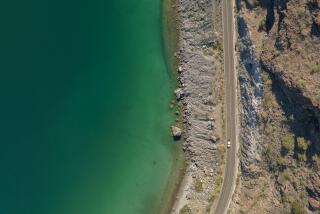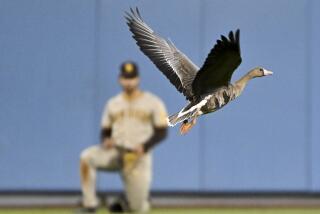Argentine Ranchers : Pioneers Tame Plains of Patagonia
- Share via
ESTANCIA LAS CORTADERAS, Argentina — The geese were back.
Rancher Bill Eddy was having breakfast--cereal with hour-old milk and tea brewed with well water--when his neighbors brought the news: Thousands of geese were feasting on the winter wheat just as it was beginning to sprout.
The geese can peck and honk their way through a field of wheat sprouts in one gluttonous day, so Eddy needed no persuading to join the neighborhood defense against them. He quickly lent his 40-year-old Piper Cub, the best weapon against the flying marauders.
Within minutes on that clear, cold morning, the plane was airborne on goose patrol over the raw, beautiful and seemingly limitless plains of Patagonia.
Family Business
Las Cortaderas is a back-land ranch on the Atlantic coast about 600 miles south of Buenos Aires. It is a family business and, in its way, representative of the problems, the progress and the pride of the Latin American countryside.
“It is an extremely bad business, of course,” Eddy told a visitor. “If we could sell everything, we could invest the capital more profitably in almost anything else. But we would never sell. This is a way of life.”
Eddy is 77 now, a widower, and he leaves day-to-day ranch management to his sons.
It is 40 miles on corrugated dirt roads from Las Cortaderas to the nearest telephone, but the isolation is relative. Here in Patagonia, and in many other parts of the South American interior, new roads and improved communications are filling a historical emptiness.
Long Trip to Town
Not long ago it took four hours by jeep from Las Cortaderas to the town of Carmen de Patagones, when the dirt track was passable at all. That is one reason for the Piper. These days, except when the ground is wet, it is hardly more than an hour by family sedan to a movie house.
“When I was a boy we went into town no more than once a month,” said William Eddy Jr., 52. “The main north-south national highway was unpaved; trucks would get stuck in the mud for five or six days.
“Life is much easier now. We run into town whenever there’s a need; too often, really.”
His father, Patagonian rancher William Edward Montague Eddy, is a blue-eyed Englishman. Neighboring farmers are descendants of German-speaking White Russians. They are a sampling of the doughty, polyglot pioneers who are helping to tame South America’s rural frontier.
In the process, the newcomers often become Latin Americans themselves. After half a century in rural Argentina, Eddy’s Spanish is still fractured, and he speaks English with his Argentine-born sons. His Argentine grandchildren, however, prefer Spanish, the language of instruction at the neighborhood’s one-room elementary school and at provincial universities where one of them studies veterinary medicine, another agronomy and still another computers.
Spanish is also the mother tongue of the Eddy grandnephews, who play casual games of polo on a dirt landing strip and wage endless wars between gauchos and Indians on almost-Shetland ponies.
There is no television at Las Cortaderas--nor any electricity, for that matter, save what a generator provides for a few hours of light at night. But no one complains. The kerosene refrigerator need not be used in the winter; a cold cupboard on the porch is sufficient.
No strangers, no itinerant salesmen come to call at Las Cortaderas. The family compound is six miles and nine gates from the nearest country road.
“A man needs to be able to see a little bit far,” son William said. “This is a place to do that. We’re not on the way to anywhere.”
That’s just what the senior Eddy wanted.
“I have achieved my goal of owning my own ranch,” he said. “I love it here, and I am extremely lucky because my family loves it, too.”
The geese like it, too.
“Damned geese,” the pilot muttered.
Gustavo Acosta, a chunky, Patagonia-wise pilot with 40 years’ experience, was flying Bill Eddy’s old Piper at 80 m.p.h., 100 feet above a checkerboard of farms and ranches. Cattle, sheep and galumphing wild ostriches fled from the plane. A flock of flamingos rose in alarm from a salt flat.
A dozen local farmers were paying Acosta to run off the intruders. It is serious work. Acosta’s eyes roved over the horizon like a fighter pilot’s.
There! Two o’clock low, on a new green field. Acosta stood the old fabric-covered Piper on its wing and, with 100 horsepower screaming, dived on the geese. Soon some 5,000 of them were fleeing the Piper with obedient dignity. Like their tormentor, the geese had played this game before.
Several Planes at Work
“It’s important to stay below them and not to go too fast,” Acosta shouted. “If they get tired and land, it’s impossible to get them back up.”
Acosta drove the geese south. His was not the only plane in the air, though, and his employers are not the only local farmers that the geese bedevil. Sometimes Acosta, herding one flock south, encounters another airborne “scarecrow” driving another flock north. Usually, there are irritated pilots and tired geese before the confusion can be sorted out.
Such byplay between man and nature on the frontier plays by old, unspoken rules. Everybody understands that the geese came long before man.
A century ago, the American naturalist William Henry Hudson watched the annual struggle in this part of Patagonia from ground level and observed:
“Early in the winter the arrival of the migratory upland geese (chloephaga magellanica) was dreaded. It is scarcely possible to keep them from the fields when the wheat is young. . . . On some estates, mounted boys were kept scouring the plains and driving up the flocks with loud shouts, but their labors were quite profitless; fresh armies of geese on their way north were continually pouring in. . . . “
Las Cortaderas is an alluring blend of modern farming and a life style that would seem quaint to Americans. But it is upscale in the context of rural Latin America.
Over the nearly four decades that Eddy has owned his ranch, the dry 20,000 acres of pastureland have been subdivided, painstakingly cleared of brush and improved with tough African grasses and water troughs for the stock.
Water pumped by windmills for the animals is too salty for human consumption. The family’s drinking water comes from rain-fed wells served by old-fashioned buckets.
Shortage of water is a plague in Patagonia even more serious than the annual migration of the geese. Average rainfall at Las Cortaderas, named for distinctive clumps of pampas grass, is less than 12 inches a year.
The Eddys raise 700 head of Aberdeen Angus cattle and 3,500 head of Merino sheep. They lease two large fields to a wheat farming neighbor in exchange for a percentage of the crop.
Marginal Land
Like many of their neighbors, they are moving away from sheep, Patagonia’s historic pride, and toward cattle. Fattened sheep brought around $16 a head at a recent sale, while cattle fetched almost 50 cents a pound live weight. Cattle, which average about 450 pounds when brought to market, can be worth $200 a head or more.
The land is marginal, almost desert. Anything taller than a bush has been planted by man. For grazing, Eddy allows one hectare (2.5 acres) for every sheep, about six for every cow.
“We might work more intensively, but a dry year would not be kind to the stock,” he said.
Being kind to the stock is the subject of a low-key Eddy family debate. The Eddy women, particularly, want cattle guards to replace gates on the ranch. Getting in and out of a car 36 times to open and close gates can take much of the pleasure out of a shopping spree to town.
“Maybe we’ll put in the guards,” Eddy said. “There are a lot of well-run ranches that have them. But, then again, I have seen horses do great damage to their legs in cattle guards.”
Each of Eddy’s sons has a house in Carmen de Patagones. Sometimes they weekend there, but mostly the houses are for the childrens’ benefit. After six grades in the one-room country school, the only alternative to school in town is a distant boarding school.
Bill Eddy, who himself went to English boarding schools when his father was general manager of one of Argentina’s first railroads and who sent his own children to boarding school, does not oppose the idea of citified Eddys. But that does not mean he necessarily agrees with it.
“I’ve never had a house in any town,” he said. “I’ve never needed one.”
Sometimes Bill Eddy flies his old Piper himself to an island off the coast where his family grazes sheep on land rented from the Argentine government. Sometimes he flies just for the fun of it. He walks with two sticks now--arthritis. But he flies like a dream. It is in the air that it is easiest to remember Eddy’s quiet reputation as Argentina’s most highly decorated Allied serviceman in World War II.
The rough dirt Patagonian runways can be tricky in the winter wind, but former Royal Air Force Squadron Leader Eddy, Distinguished Service Order, Distinguished Flying Cross, scarcely notices. All landings have been easy since the one in a Belgian field in 1944.
Eddy was in high spirits piloting P-for-Peter when it bombed Augsburg in southern Germany the night of Feb. 25-26. Then flak set off a fire in the cockpit and ruptured the fuel tank. Bill Eddy dived to put out the fire and ordered his six-man crew to jump.
“The crew expressed the wish to remain with him as he had no parachute, but the captain repeated his order,” the official RAF account says. The crew jumped safely.
Walked to Safety
Flying alone, propellers feathered, all power and hydraulics gone, Eddy pancaked the four-engine bomber into a snow-covered field at 2 a.m. When he came to, he destroyed secret navigational equipment, set fire to the plane, rescued a thermos of coffee and some sandwiches and started walking.
“At dawn a flight of wild ducks got up with a fright and much quacking,” he wrote years later. “It made me think of shooting with my wife on mountain streams in Patagonia. I resolved to evade capture.”
With no clear idea of where he was, Eddy knocked on the door of the first farmhouse that he came to. He was in luck: The farm family worked for the Belgian Resistance. The Belgians passed him through occupied Brussels to France, where the French Resistance passed him through occupied Paris and eventually to neutral Spain two months later.
He returned to combat as a pathfinder in RAF Mosquitoes, marking targets for the big bombers behind him. Eddy flew his last mission, his 80th, against Berlin on April 20, 1945. Then he went home--to Patagonia.
There are winter days now when the arthritis is biting and the Piper in its hangar seems as far away as a distant war. Often, if there are supplies to be taken to the island, one of Eddy’s sons will volunteer to fly them.
Then Bill Eddy sits in contentment with his pipe by the fire, listening critically to the engine noise as the Piper takes off. The pilot is an Eddy named Peter, after the Lancaster that was lost in occupied Europe on the same night he was born.
More to Read
Sign up for Essential California
The most important California stories and recommendations in your inbox every morning.
You may occasionally receive promotional content from the Los Angeles Times.













